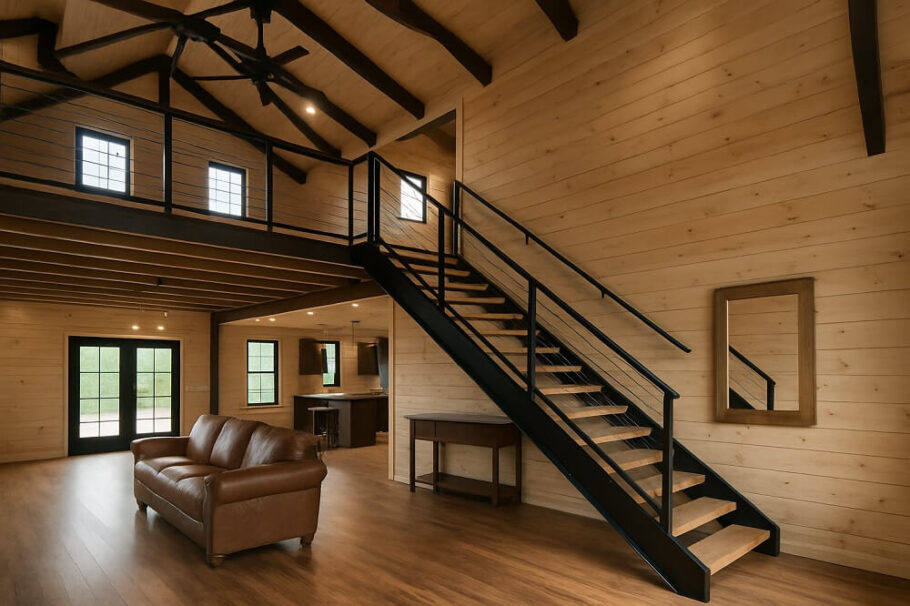When designing a barndominium, it’s easy to get caught up in big-ticket items like the floor plan, roofline, or window placement. But if your barndo has more than one level, there’s one crucial design feature that deserves serious attention: the staircase.
Staircases are more than just functional—they’re a core architectural element that can elevate the look and feel of your entire home. Whether you’re going for rustic farmhouse, sleek industrial, or modern minimalism, the right staircase design can tie your vision together.
In this post, we’ll break down the three most popular barndominium staircase styles: spiral, floating, and classic. We’ll explore the pros, cons, style aesthetics, space considerations, and material options to help you decide which the best fit for your barndo is.
Why Staircase Design Matters in a Barndominium
Barndominiums are known for their open floor plans, high ceilings, and flexible layouts. Unlike traditional homes that have more rigid architectural limits, barndos give you freedom, and that includes how you design vertical transitions between floors.
Your staircase can become a focal point, a statement piece, or blend subtly into the background, depending on your goals. It also plays a functional role in terms of space efficiency, safety, and ease of movement.
So, whether you’re building from scratch or remodelling an existing space, choosing the right staircase is key to both form and function.
1. Spiral Staircases: Compact & Eye-Catching
Spiral staircases are a favorite among barndominium owners, and it’s easy to see why. They’re visually striking, space-saving, and work well with both rustic and modern aesthetics.
Pros:
- Space Efficient: Spiral stairs take up a small footprint, which is great for barndos with limited floor space.
- Aesthetic Appeal: Their circular motion draws the eye and creates an architectural centerpiece.
- Customization: Available in materials like wrought iron, wood, steel, or a combination, you can tailor them to suit industrial, farmhouse, or contemporary styles.
Cons:
- Less Practical: Not ideal for moving large furniture or heavy items between floors.
- Steeper Climb: The rise and run of spiral stairs can be more difficult to navigate, especially for young children, elderly people, or pets.
- Building Code Considerations: Some municipalities limit their use as a primary staircase; be sure to check local codes.
Best For:
- Loft spaces, guest suites, or mezzanine areas.
- Homeowners are looking to maximize floor space or add an architectural feature.
Design Tip:
Consider a black wrought iron spiral staircase with wooden treads if you want a blend of industrial and rustic charm. Or go all-metal for a clean, contemporary twist.
2. Floating Staircases: Modern Elegance with Industrial Edge
Floating stairs, also known as cantilevered or open-riser staircases, appear to “float” because they lack traditional risers and often have hidden supports. This design is ultra-modern and fits beautifully with a clean, minimalist barndominium.
Pros:
- Modern Look: Floating stairs scream high-end, modern design.
- Light & Airy: Without risers, light passes through, making the space feel bigger and brighter.
- Customization: Wood, glass, metal, cable railings—you have lots of design freedom.
Cons:
- Cost: Typically more expensive due to complex engineering and installation.
- Safety: Open risers and minimal railings may not be ideal for homes with kids or elderly occupants.
- Structural Requirements: They require secure attachment to walls or reinforced structural supports.
Best For:
- New builds where the staircase can be integrated from the start.
- Modern or industrial-themed barndominiums.
- Homeowners who want a sleek, open-concept interior.
Design Tip:
Pair wooden floating treads with black steel railings and cable wire for a modern farmhouse look. Add LED lights underneath each step for a dramatic evening effect.
3. Classic Staircases: Timeless and Versatile
The classic staircase—straight or L-shaped with risers and solid handrails—offers timeless appeal and broad versatility. While it may not be as flashy as a spiral or floating staircase, it’s practical, accessible, and customizable.
Pros:
- Functionality: Easier to climb, safer for all ages, and better for moving furniture.
- Design Flexibility: You can tweak materials, colors, balusters, and railing styles to suit any décor.
- Cost-Effective: Often more affordable than floating stairs.
Cons:
- Space Usage: Requires more floor area than spiral stairs.
- Less “Showy”: Doesn’t always make the same bold visual statement.
Best For:
- Families or multi-generational homes.
- Traditional, rustic, or transitional barndominium styles.
- Homes with ample space to accommodate a larger staircase.
Design Tip:
Use reclaimed wood treads with white risers and a black iron railing to give your staircase a warm, farmhouse vibe. Or go all-wood for a cozy cabin feel.
Choosing the Right Staircase: Factors to Consider
Still torn between spiral, floating, or classic? Here are a few key things to keep in mind when making your final decision:
- Space Availability
- Small footprint? Go spiral.
- Open floor plan with lots of light? Floating could be perfect.
- Larger layout with room to spare? A classic staircase fits easily.
- Budget
- Spiral and classic designs tend to be more affordable.
- Floating staircases often cost more due to engineering and materials.
- Functionality
- Think about who will be using the stairs. Young children? Grandparents? Pets? Consider safety and ease of use.
- Style Compatibility
- Match the staircase style to your barndo’s overall aesthetic.
- Think about materials—wood, metal, glass—and how they coordinate with other finishes in the home.
- Building Codes & Permits
- Local codes may limit certain styles for use as a primary staircase.
- Always check with your contractor or building inspector before finalizing your design.
Materials That Make a Statement
No matter which staircase style you choose, the material selection can make or break the look. Here are some popular combinations to consider for your barndominium:
- Wood & Steel: A great mix for rustic-industrial barndos.
- Glass & Metal: Ideal for contemporary or minimalist homes.
- All-Wood: Works well for classic farmhouse or cozy cabin vibes.
- Cable Railings: Add a modern touch and keep sight lines open.
Bonus: Adding LED lighting under steps or in the handrail adds both flair and functionality.
Final Thoughts: It’s More Than Just Stairs
Your staircase isn’t just a way to get from one level to another—it’s a major design moment. Whether you’re captivated by the elegance of a floating staircase, the charm of a spiral, or the timeless appeal of a classic design, the right choice will make your barndominium feel more cohesive, stylish, and functional.
Before you build, sketch it out, look at inspiration photos, and talk with your architect or designer. This is one area where thoughtful planning pays off in both beauty and utility.
So—Spiral, Floating, or Classic? Which one are you leaning toward?
Need help designing your dream barndo, including the perfect staircase? Our team at Alldraft Design Services can help bring your vision to life with detailed plans tailored to your lifestyle and space. Contact us today for a free consultation!

